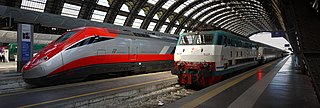
The Italian railway system is one of the most important parts of the infrastructure of Italy, with a total length of 24,227 km (15,054 mi) of which active lines are 16,723 km. The network has recently grown with the construction of the new high-speed rail network. Italy is a member of the International Union of Railways (UIC). The UIC Country Code for Italy is 83.

The Italian railway system is one of the most important parts of the infrastructure of Italy, with a total length of 24,227 km (15,054 mi) as of 2011.
Giuseppe Bianchi was an Italian railway engineer on the Ferrovie dello Stato between 1913 and 1946.

Ferrovie Nord Milano is an Italian public transport company: the second largest railway company in Italy. It operates primarily in the northern Italian regions of Lombardy and Piedmont and in Canton Ticino in southern Switzerland. Listed on the Borsa Italiana, its main shareholders are the Lombardy Region (57.57%), Ferrovie dello Stato (14.5%) and Aurelia S.p.A. (3%).

ALe 426/506 TAF is an Italian Electric Multiple Unit (EMU) used mainly on commuter regional trains. Concept design has been made by Italian designer Pininfarina.

The Malpensa Express is an airport rail service linking the city of Milan with Malpensa Airport, in the region of Lombardy, Northern Italy.
LeNORD S.r.l. was a subsidiary of the FNM Group responsible for operating passenger train services in northern Italy.
Most railway stations in Italy are maintained and operated by RFI, a subsidiary of Ferrovie dello Stato Group. A minor part of them are operated by private and regional companies, conceded by the state.
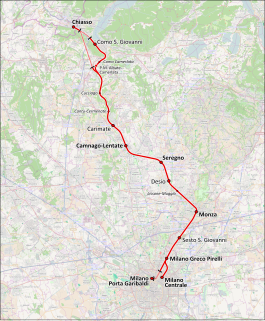
The Milano–Chiasso railway line is an Italian state-owned railway connecting Milan to Como and Chiasso, Switzerland.
Ghisolfa is a district ("quartiere") of Milan, Italy, part of the Zone 8 administrative division of the city, located north-west of the city centre. It is named after the "Ghisolfa Bridge" overpass, part of the external Circonvallazione ring road enclosing the centre of Milan. In turn, the bridge was named after two cascine, "Cascina Ghisolfa" and "Cascina Ghisolfetta", that existed in the area before the urbanization of the mid 20th century. The bridge was completed in 1941, prolonged in the 1960s, and enlarged in the 1990s.
FERROVIENORD S.p.A. is an Italian transport company, part of the FNM Group, that manages the network of regional railway concessions owned by the group in northern Italy.

Affori Centro is a station on Line 3 of the Milan Metro which opened on March 26, 2011, twenty-one years after the opening of the original trunk of the line. It is one of the four stations on Line 3 opened to the public in 2011, forming the section from Dergano to Comasina.
Società Costruzioni Industriali Milano, better known as Socimi, was an Italian manufacturing company based in Milan. It was a manufacturer of trams, metro trains; traction motors for these and for trolleybuses; and bodies for motorbuses and trolleybuses. It also manufactured weapons, such as rifles. The company was founded by Alessandro Marzocco in 1969 and declared bankruptcy in 1994 due to its involvement in the Mani pulite scandal in 1992.

Trenord is a railway company which is responsible for the operation of regional passenger trains in Lombardy. The company was established by the two main railway companies in Lombardy, Trenitalia and Ferrovie Nord Milano (FNM), to manage train operations in the region. The equity is equally divided between the two companies.

The E.750 is a class of electric railcars of the Italian railway company Ferrovie Nord Milano.

The Milan–Asso railway is a regional railway line with standard track gauge which links Milan to Canzo crossing for Erba and other towns in Brianza. The most northern terminal is the station of Canzo-Asso, which is located in Canzo's territory but is commonly known as Asso in the short form. That, because there is another station on the line called Canzo station and Canzo-Asso is next to Asso's boundary and serves this commune too.
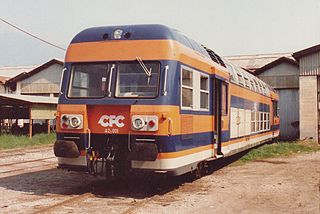
The A2n 001 was an experimental Diesel railcar built in Italy by CaFiCi consortium in 1982. Despite a long test period in several regional lines, the vehicle never came into regular service.

The Museo delle Industrie e del Lavoro del Saronnese in Saronno is a science and technology museum, displaying industrial heritage strictly related to the industries in the area of Saronno town, north of Milan. It was opened on 25 October 1998.
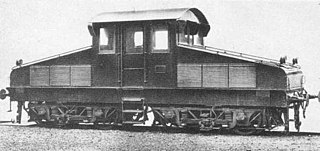
FS class E.420 locomotive was a third rail electric locomotive built for the operation of the Milan - Gallarate - Varese railway in Italy.
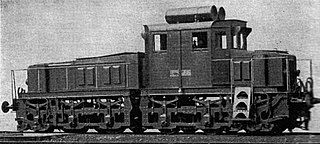
FS Class E.620 was a class of third-rail electric locomotives built by Officine Reggiane for the Italian State Railways (FS). They were built in 1925 using motors and electrical equipment from Class E.10 railcars [Automotrici_RM_5111-5130] which had been withdrawn in 1923. They were equipped with six nose-suspended direct current traction motors with a total output of 950 kW. The drive to the axles was by gears and the maximum speed was 85 km/h. After World War II they were converted to 3,000 volt DC operation and became FS Class E.621.















